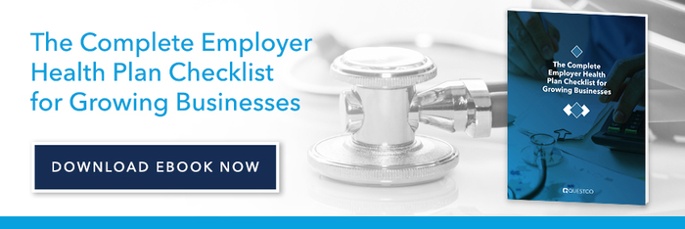Topic Employee Benefits,
10 Ways to Lower the Price of Healthcare for Employers

August 11, 2023 | By Laura Platero

Employers can expect health care costs to rise by an average of 5.6% in 2023. This will be accompanied by high overall inflation, which currently rages at 8.5%.
Industry observers are warning that group health insurance premiums may rise even higher than general healthcare costs due to the impact of the Inflation Reduction Act (IRA). Congress passed the IRA as a climate and tax reduction act; however, several provisions in it may increase group healthcare plan premiums. For example, the drug pricing provisions that apply only to Medicare coverage raise concerns that the IRA may shift costs to the commercial industry side.
As a result, businesses are looking to adopt cost-containment features that do not negatively impact the quality of care or employee cost-sharing features under group health plans.
The five most effective ways to reduce employer healthcare costs are:
- Offering High Deductible Health Plans (HDHPs) with Health Savings Accounts (HSAs)
- Using individual coverage Health Reimbursement Arrangements (HRAs)
- Educating employees on healthcare spending and wellness
- Finding a SHOP Plan
- Partnering with a professional employer organization (PEO)
The following briefly describes each of these cost-saving features.
Idea #1: Adopt High Deductible Health Plans with HSAs
A High Deductible Health Plan (you may see them referred to as HDHPs) charges a lower premium than traditional insurance plans, but there is a trade-off. The covered person in an HDHP pays a higher deductible. In short, employees will typically have higher out-of-pocket expenses before the insurance plan pays anything. However, there are other attractive features of a HDHP that can save you money.
An HSA is a Health Savings Account that many times accompanies an HDHP. An HSA allows employees to save tax-free dollars to help pay for covered medical expenses. Once they accumulate money in the account, employees may then use the HSA funds to pay for qualified medical expenses such as dental, vision, prescription drugs, and other medical costs. An HSA account has additional benefits, such as the ability to invest the HSA contributions over time. Employees will need to keep in mind that there are annual limits to their contributions into an HSA.
The PROs
HDHPs with and without HSAs save employers money. The monthly premiums are lower than traditional group health plans. HDHP plans also teach employees invaluable healthcare utilization lessons and incentivize them to consider their wellness steps carefully.
Employees appreciate the ability to make tax-free contributions to HSAs to help defray the costs of qualified medical expenses.
The Cons
As mentioned, HDHPs have higher out-of-pocket costs to meet the plan's deductible. The side effect of higher employee cost-sharing may result in patients foregoing the medical care they need.
In addition, employees often perceive the creation of HDHPs as an increase in their cost-sharing responsibilities. This may result in an adverse employee reaction to participation in the HDHP.
Idea #2: Adopt Individual Coverage Health Reimbursement Arrangements
Health Reimbursement Arrangements (HRAs) provide individual coverage that gives employers an alternative to traditional group healthcare plans. The individual coverage account allows the employer to provide tax-free reimbursements to employees for payment of plan-specified medical expenses, such as co-payments, deductibles, and health coverage premiums. To qualify, the employee must enroll in an individual health insurance plan.
The PROs
Employees enjoy considerable tax-favored treatment on HRA reimbursements. HRA reimbursements are also free from payroll taxes and income taxes if the employee purchases an individual health insurance policy on a state or federal marketplace.
Minimum participation and minimum contribution requirements do not apply to HRAs. Employees appreciate the flexibility of using the HRA funds to buy the health coverage that works best for them and their families.
The CONS
Some features may not seem like advantages to every employee or employer. For example,
- HRA plans may disqualify individuals from a Premium Tax Credit that could help subsidize their medical premium.
- Employees may also have to deal with more paperwork with HRAs than in more traditional plans.
- HRAs are not available to self-employed business owners, partners, LLC members, and 2% shareholders in S-Corporations.
- Employers would also need to consider how the plan would impact cash flow if a high number of employees need reimbursements simultaneously.
Idea #3: Educate Employees on Healthcare Spending and Wellness
Employers can find it beneficial to take the time to educate their employees on becoming better at spending the healthcare dollars available to them. For example, wellness programs significantly lower healthcare costs by keeping employees healthy and fit. Employers find it cost-efficient to pay healthcare dollars toward wellness programs, such as smoking cessation, gym memberships, and nutritional instruction, rather than the exorbitant medical expenses associated with diabetes, heart disease, and high blood pressure.
To be effective, each employer must communicate the particulars of a wellness program to their employees, so they understand how vital the program is to keep them healthy and trim.
The PROs
To summarize the benefits of employee health education, consider the following:
- Employee health education and awareness cost the employer more in terms of time than it does money.
- Incentivizing employees to participate in Wellness programs often results in lower utilization of more expensive healthcare services.
The CONs
As with most choices employers must make, employers may encounter some disadvantages at first. For example,
- Convincing skeptical employees to use the Wellness programs may require incentives.
- The reductions in healthcare costs will only occur over the long term.
Idea #4: Find a Small Business Health Options Program (SHOP) Plan
The Small Business Health Options Program (more popularly known as SHOP) helps small employers, typically fewer than 51, provide health and dental benefits to their employees at an affordable price.
The PROs
SHOP advantages include the flexibility to offer one plan or multiple plans. SHOP also makes the business eligible to take advantage of the Small Business Healthcare Tax Credit. The Small Business Healthcare Tax Credit may pay up to 50% of the costs of employer healthcare premiums.
The CONs
Employers may find SHOP less than favorable for the following reasons:
- SHOP is only available to businesses that have fewer than 51 full-time employees.
- More than 70% of eligible employees must enroll in the SHOP plan.
- Employers cannot adopt SHOP from the federal marketplace.
Idea #5: Promoting Preventive Care
Preventive care is all about catching health issues before they become serious problems. It includes regular check-ups, screenings, and vaccinations. The idea here is simple: it's easier (and cheaper) to prevent a disease than to treat it.
The PROs
By promoting preventive care, employers can help employees stay healthy and avoid costly treatments down the line. It's a win-win situation: employees get to enjoy better health, and employers get to save on healthcare costs.
The CONs
The challenge here is getting employees to take advantage of preventive care services. Some people might skip check-ups and screenings because they feel fine, not realizing that some health issues don't show symptoms until they're advanced.
Idea #6: Implementing Disease Management Programs
Disease management programs are designed to help employees manage chronic conditions like diabetes or heart disease. These programs provide education, support, and tools to help employees take control of their health.
The PROs
By helping employees manage their chronic conditions, these programs can prevent complications and reduce the need for hospitalizations, which can be quite costly.
The CONs
The effectiveness of disease management programs depends largely on employee participation. If employees don't engage with the program, the benefits may be limited.
Idea #7: Encouraging the Use of Telemedicine
Telemedicine allows employees to consult with healthcare providers remotely, using video calls or other digital communication tools. It's a great option for non-emergency situations and routine check-ups.
The PROs
Telemedicine can reduce the need for expensive emergency room visits and allow for more convenient care. It can also save employees time, as they don't need to travel to the doctor's office.
The CONs
Not all health issues can be addressed through telemedicine. Also, some people might prefer face-to-face consultations and may be hesitant to use telemedicine services.
Idea #8: Promoting Generic Drug Use
Generic drugs are copies of brand-name drugs. They have the same active ingredients and are just as effective, but they're usually significantly cheaper.
The PROs
By encouraging employees to use generic drugs whenever possible, employers can significantly reduce healthcare costs.
The CONs
Some employees might have the misconception that generic drugs are of lower quality than brand-name drugs. It's important to educate employees about the effectiveness and safety of generic drugs.
Idea #9: Offering Flexible Working Hours or Remote Work
Flexible working hours and remote work can reduce stress and improve work-life balance, which can have a positive impact on employees' health.
The PROs
Happier, less stressed employees are likely to be healthier, which can lead to lower healthcare costs. Plus, offering flexibility can boost employee morale and productivity.
The CONs
Not all roles are suited to flexible or remote work. Also, managing a remote team can be challenging and may require additional resources.
Idea #10: Partner with a Professional Employer Organization (PEO)
A Professional Employer Organization (referred to as a PEO) consists of experienced HR professionals that partner with small employers to help cut costs, streamline administration, and shift risk.
The PROs
Partnering with a PEO means employers may choose to pool all their employees together to negotiate for better prices through economies of scale. The PEO offers Fortune 500 level benefits at the price that small businesses can afford. PEOs also offer the most stable renewal rates.
The PEO assumes responsibility for all benefits administration as well as tax remittance duties. Employers may choose to retain their existing healthcare plan or join the PEO's health plan.
The CONs
The one downside is that an employer who joins the PEO's medical insurance is limited to the PEO's plans.
What is the Best Way to Reduce Employer Healthcare Costs?
On average, PEOs provide a return on investment of about 27%. PEOs accomplish this through potential savings in several areas, such as taxes, workers compensation, and service fees. However, one of the biggest areas of potential savings for both employers and employees is in the area of health insurance. The more employees that participate in a healthcare plan, the less risk, which is why insurance carriers are willing to negotiate lower premiums, especially when negotiating with a PEO.
Finally, hiring a PEO partner is the only way small business owners can afford to offer their employees Fortune 500-level benefits. If an employer desires to keep their existing medical insurance, the PEO will work with the broker or insurance carrier to administer benefits cost-effectively. It's a win-win scenario.
.jpg)
Laura Platero
Laura serves as the Director of Product Strategy. She is an expert in large scale benefits account management, project management, product development, sales, customer service, and benefits consulting.



